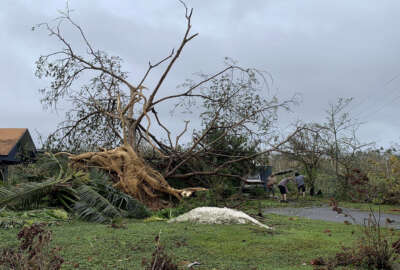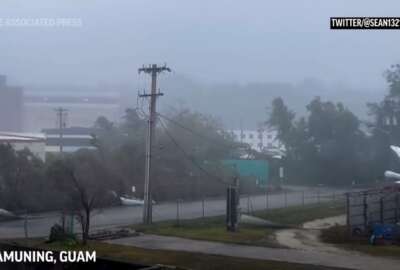
Residents of Guam still recovering after typhoon
Two weeks after a Category 4 typhoon hit Guam, many residents still lack necessities.
In the aftermath of Typhoon Mawar, roughly half the residents of Guam, including military service members and civilian Defense Department employees, still have no power and water. Although progress is being made to restore utilities, homes sustained damage and residents lost food and possessions as a result of the typhoon’s high winds and heavy rain.
Karen Fahland, the director of the Navy Marine Corps Relief Society and a nine-year resident of the island, said it was the worst storm she had ever seen.
“The one thing that saved a lot of people here [near the naval base] is that many of the structures are concrete. Other places it’s total devastation. The northern part of the island unfortunately had houses that are now uninhabitable,” Fahland said.
She said in her own home, a condo by the beach, typhoon shutters were torn off the building and the rain came in horizontally.
Navy and Marine Corps service members and military retirees who live on the island make up a significant number of residents who suffered losses from the storm. The island has over 150,000 residents, and more than 20,000 are military members and their families. They are still trying to recover from damage to their homes and property both on and off the naval base. The Category 4 typhoon hit the island on May 24 with 140-mile-per-hour winds and heavy rain.
Navy Base Guam lost power initially but now has utilities restored and potable water.
“DoD got power back relatively quickly, probably about eight days after the storm, but that’s still a long time to live without power. They did have water, which was a good thing. They have powered through it. They’ve been very proactive in getting back up and running as quickly as possible,” Fahland said.
The Navy Marine Corps Relief Society (NMCRS) office on Guam remains without power, but staff and volunteers have been able to work from temporary quarters to get aid to the island’s Navy and Marine families and retirees in the wake of the storm.
Shortly after the storm, the society’s three full-time employees and 30 volunteers set up a booth to start distributing aid in the form of grant money. Fahland said they have a quick, easy system for getting people funds if they qualify.
“It’s a very seamless process. It’s what we do, we’re here to help. We ask that they are either active duty or retired, Navy or Marine Corps. They show us an ID and fill out a very simple form. And we write them a check,” Fahland said.
As of Thursday, the organization had given out over $1.1 million in grants to residents affected by the storm. NMCRS gave individuals $300 and families $600 in funds designed to help with recovery. The grants went out to 2,105 active duty military members and 118 retirees.
“I have pictures of lines that people were waiting for two to three hours to come and see if they could get just a little bit of money to help them after having to throw away all of their food.” Fahland said. “They have also had to stand in line for gas for two or three hours. And that was the initial impact right after the storm.”
While Fahland said most military housing survived the storm, the lack of power meant moisture quickly turns to mold in the tropical heat.
“A lot of people experienced in varying degrees water that got into their property. Once that water got into their property and you take away that power — it’s a humid area here anyway, so the mold started to grow. Now they’re having to throw things away. They’re having to throw their clothing away or they’re having to throw books away. It’s interesting how mold is just growing on so many different things,” Fahland said.
She said the NMCRS depends on donations to fund its efforts. Anyone wanting to donate should go to the NMCRS website.
Copyright © 2025 Federal News Network. All rights reserved. This website is not intended for users located within the European Economic Area.
Alexandra Lohr, a former staff member, covered the Defense Department for Federal News Network until September 2023.
Related Stories





